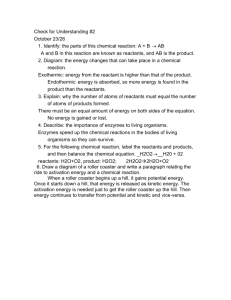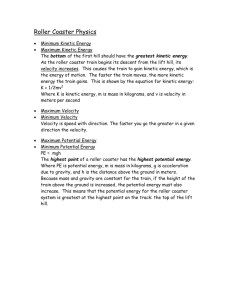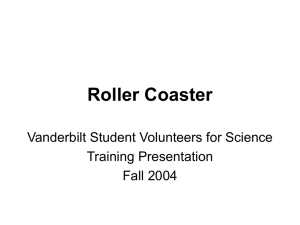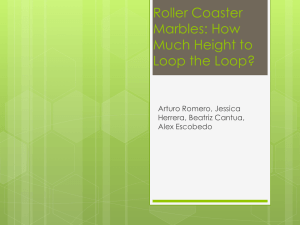Summary of lesson
advertisement
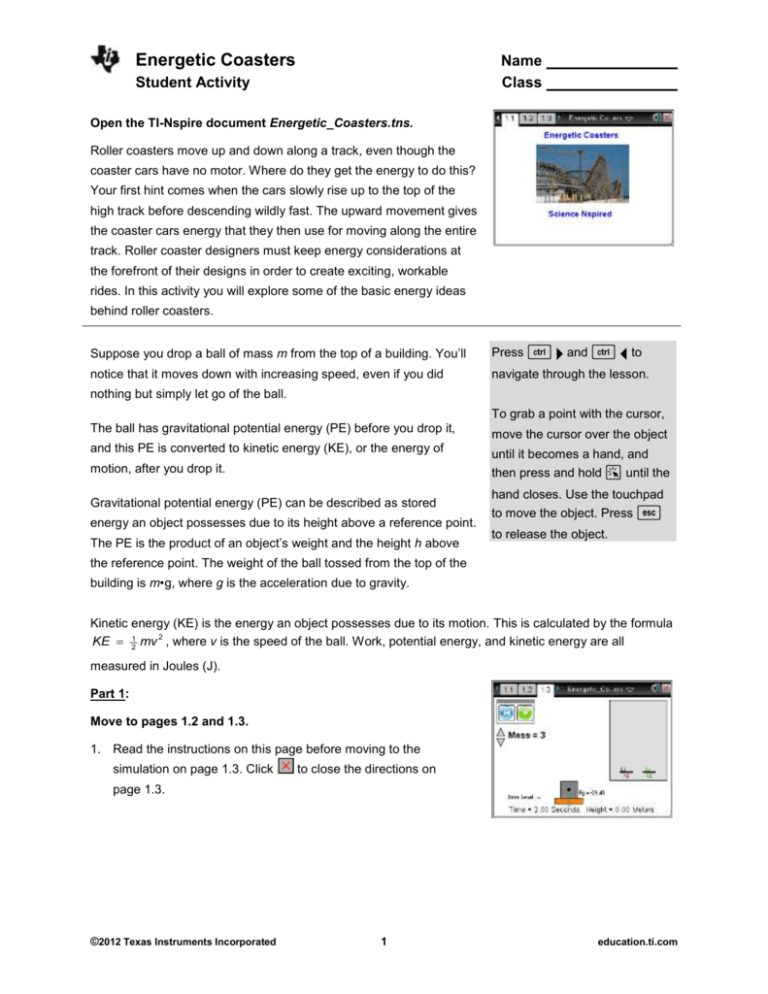
Energetic Coasters Name Class Student Activity Open the TI-Nspire document Energetic_Coasters.tns. Roller coasters move up and down along a track, even though the coaster cars have no motor. Where do they get the energy to do this? Your first hint comes when the cars slowly rise up to the top of the high track before descending wildly fast. The upward movement gives the coaster cars energy that they then use for moving along the entire track. Roller coaster designers must keep energy considerations at the forefront of their designs in order to create exciting, workable rides. In this activity you will explore some of the basic energy ideas behind roller coasters. Suppose you drop a ball of mass m from the top of a building. You’ll Press / ¢ and / ¡ to notice that it moves down with increasing speed, even if you did navigate through the lesson. nothing but simply let go of the ball. To grab a point with the cursor, The ball has gravitational potential energy (PE) before you drop it, move the cursor over the object and this PE is converted to kinetic energy (KE), or the energy of until it becomes a hand, and motion, after you drop it. then press and hold a until the Gravitational potential energy (PE) can be described as stored energy an object possesses due to its height above a reference point. The PE is the product of an object’s weight and the height h above hand closes. Use the touchpad to move the object. Press d to release the object. the reference point. The weight of the ball tossed from the top of the building is m•g, where g is the acceleration due to gravity. Kinetic energy (KE) is the energy an object possesses due to its motion. This is calculated by the formula KE 21 mv 2 , where v is the speed of the ball. Work, potential energy, and kinetic energy are all measured in Joules (J). Part 1: Move to pages 1.2 and 1.3. 1. Read the instructions on this page before moving to the simulation on page 1.3. Click to close the directions on page 1.3. ©2012 Texas Instruments Incorporated 1 education.ti.com Energetic Coasters Name Class Student Activity 2. On page 1.3, you will find a block on a surface. You may grab the block by the point in the middle and lift it above the surface. The force required to lift the block and the height of the block above the surface is displayed on the screen. The product of these numbers is the work done on the block. As the block is lifted, a bar graph measures its gravitational potential energy. Another bar graph measures the kinetic energy of the block. Answer questions 1-4 on this worksheet as you work with the simulation. Q1. Move the block to a height of 0.99 m. What is the PE of the block? What is the KE? Q2. Press the play button Q3. Run the simulation four more times, by setting the height of the block and then pressing play. You . What happens to the PE and KE values as the block drops? will need to press reset before running the simulation again. Complete the table below for each simulation. Height Q4. PE KE PE + KE PE KE PE + KE pre-drop pre-drop pre-drop post-drop post-drop post-drop What do you notice about the total energy (PE + KE) throughout the block’s drop? Part 2: Move to pages 2.1-2.2. 3. Read the information on this page and on pages 2.1 and 2.2. Roller coaster cars are not lifted straight up and they do not fall freely. Instead, they move up and down hills. In this activity, you will see a block with a mass of 3 kg at the bottom of an inclined plane. ©2012 Texas Instruments Incorporated 2 education.ti.com Energetic Coasters Name Class Student Activity First you will look at the force required to pull the block and the distance it is pulled. The product of force and distance is equal to the work done on the block. You will then observe the potential energy of the block at the top of the incline. Finally, you will see the potential and kinetic energies of the block as it slides down the inclined plane. You can click to close the directions on page 2.3. Move to page 2.3. 4. A 3-kg block starts at the bottom of a frictionless hill. Grab the point on in the middle of the block and move the block up the incline. The force, F, required to pull the block and the distance pulled, x, are shown on the screen. As the block is pulled up the incline, a bar in the bar graph measures its potential energy. As the block slides down the incline another bar measures its kinetic energy. Answer questions 5-7 on this worksheet before moving on to page 2.4. Q5. Move the block to the 1-m mark. Record the information from the bar graph in the table below. Press the play button . Record the information in the last three columns in the table below. Run the simulation four times to gather enough data to complete the table. You will need to press reset before running the simulation again. Height PE KE PE + KE PE KE PE + KE pre-drop pre-drop pre-drop post-drop post-drop post-drop Q6. What do you notice about the total energy (PE + KE) throughout the block’s descent? Q7. Describe what happens with the gravitational potential and kinetic energies as the block slides down the hill. Compare the kinetic energy of the block when it reaches the bottom to the gravitational potential energy at the point of release. ©2012 Texas Instruments Incorporated 3 education.ti.com Energetic Coasters Name Class Student Activity Move to pages 2.4–2.6. Answer questions 8-10 on this worksheet and/or in the .tns file. Q8. The potential energy of an ideal roller coaster at its highest point is equal to the work required to get it to the top of the hill. True or False? Q9. Choose the correct statement(s) about kinetic energy, KE, and potential energy, PE, based on your observations of the block on the frictionless incline. (There is more than one correct statement.) A. The KE and PE of the block are always equal. B. As the block slides down the hill, its KE increases at the same rate as its PE decreases. C. As the block slides, the sum of its KE and PE remains constant. D. The total energy of the block (KE + PE) increases as the block slides down the incline and gets faster. E. The greater the height of the block when it is released, the more KE it will have when it reaches the bottom. Q10. On a real roller coaster, how does it gain its initial potential energy? If you’ve ever played air hockey, you know that a puck will move across the table and continue moving for a long time because of the cushion of air. That air cushion reduces the friction between the puck and the table. Try that without the cushion of air and you’ll see how the puck comes to an almost immediate stop. You can now investigate the movement of the block down the incline when there is friction. Part 3: Move to pages 3.1 and 3.2. 5. Read the information on page 3.1. 6. After reading the directions on page 3.2, press to close the window. A more realistic picture of the block on a hill includes friction resisting the motion of the block. On an actual roller coaster, friction and air resistance oppose the motion. Forces that oppose motion do negative work on the object. This work is negative because the direction of the friction force is opposite to the direction of motion. This simulation includes a friction force acting on a 3-kg block as the block slides down a 30° incline. ©2012 Texas Instruments Incorporated 4 education.ti.com Energetic Coasters Name Class Student Activity Answer questions 11 and 12 before moving on to page 4.1. Q11. Move the block to the top of the incline. Note the gravitational potential energy of the block at the top of the hill. Click the play button . Observe the work and energy bar graphs as the block slides. Describe the changes you observe in the gravitational potential energy and the kinetic energy of the block as it slides. Compare the kinetic energy at the bottom of the hill to the gravitational potential energy at the top. Q12. How much work was done by the friction force? What effect did this appear to have on the energy of the block? Part 4: Move to pages 4.1 and 4.2. Now you can investigate the motion of a roller coaster on a track that includes peaks and valleys. 7. Read the information on page 4.1. Page 4.2 simulates a roller coaster car moving along a track. The height and speed of the car along with the distance traveled along the track are displayed. On the right side of the screen are bar graphs for potential energy, kinetic energy, total mechanical energy, and work done by friction. The total mechanical energy is the sum of the potential and kinetic energies. 8. After reading the directions press of the track. Clicking the play button to close the window. The roller coaster car is already at the top will release the car. Clicking the reset button will place the car back at the top of the roller coaster. You may change the friction, , by clicking the up and down arrows (£ or ¤) for Mu. You should note the velocity as the coaster moves up and down hills. The bar graph shows the corresponding changes in potential, kinetic, and total energy. Q13. Set the value of Mu to zero. Press the down arrow ¤ a couple times after it shows Mu = 0.00. What do you notice about the total energy (TE) throughout the car’s ride along the track? Q14. Set the value of Mu to 0.10. Press the up arrow £ a couple times after it shows Mu = 0.10. What do you notice about the total energy (TE) throughout the car’s ride along the track? ©2012 Texas Instruments Incorporated 5 education.ti.com Energetic Coasters Name Class Student Activity Q15. What do you think accounts for the changing TE when Mu = 0.10? Q16. At what part along the track is the PE of the car the maximum? Is this true whether there is friction or not? Q17. At what part along the track is the KE of the car the maximum? Is this true whether there is friction or not? Move to pages 4.3–4.6. Answer questions 18-21 here and/or in the .tns file. Q18. A roller coaster achieves maximum speed (ignore friction) ___________________. A. at the bottom of any hill C. anywhere on the track which is not at the top of a hill B. at the lowest position of the track D. part way down the first hill Q19. To increase the maximum speed of a roller coaster, a designer should ____________________. A. make the track shorter C. have fewer hills B. make the track longer D. make the first hill taller Q20. In the absence of friction, the greatest height a roller coaster can achieve __________________. A. is higher than the first hill C. is equal to the height of the first hill B. is much lower than the first hill D. is determined by the most recent hill it has passed over Q21. A roller coaster is not moving ____________________. A. when the total energy is PE only C. when PE = 0 B. when KE is greater than 0 D. when the total energy is KE only ©2012 Texas Instruments Incorporated 6 education.ti.com


